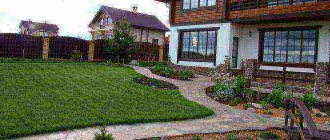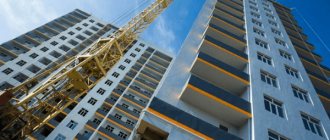Basic Concepts
The adjacent territory is a plot of land that borders a building and is used by the owner of the building to meet his needs.
In the legislation of the Russian Federation there is no precise definition of the local area of a private house. Usually it refers to a part of the land near the yard of the house owner, which he needs to maintain his plot.
Mostly, owners of private houses completely enclose their property with a fence. It is a mistake to believe that the territory behind the fence has no owner. This land belongs to the municipality. In order to obtain the right to use this land in their own interests or dispose of it, the owner of a private house must justify his easement.
All legal issues are regulated by the Constitution of the Russian Federation, the Civil Code, the Land Code, the Law “On the State Real Estate Cadastre”, cadastral and technical documents for land.
Procedure for marking boundaries
To determine the clear boundaries of the local area of a private house, first of all, look at the cadastral passport of the land plot. After privatization, it must indicate not only the boundaries of the private property itself, but also the adjacent area that belongs to it.
For residents of the private sector, there is no exact number of meters that the local area can occupy. In each specific case, the size of the local area of a private house may differ. To determine the boundaries of the territory that applies specifically to your private home, you need to consider the following points:
- draw a plan diagram of the site and indicate on it all the objects necessary for the use of a private house.
- Mark on your plan diagram the municipal part of the land that is adjacent to your property.
- Coordinate all controversial issues with the owners of neighboring plots claiming to use this territory.
- Provide documents to the Authorized State Bodies to establish the rights to use and own the local area.
Next we will talk about what can be considered a local area, how many meters from a private house?
Fencing installation
The owner has the right to independently select a suitable fence, focusing only on his own capabilities and goals.
It allows you to separate private property from municipal property. Installation of a fence will also require coordination with neighbors , as well as:
- Bodies responsible for the state system of architectural and construction supervision.
- With the main unit of the Ministry of Emergency Situations in the region.
The departments of construction and architecture, as well as property management, will require photographs of the property and documents containing basic information about the house, site and fence from the owner of the fence.
Without the consent of neighbors and authorities, a fence built is considered an unauthorized construction. If violations are discovered during the construction of the fence, the case may go to court. He may decide on complete or partial dismantling.
A fence or other fencing must be installed taking into account the boundaries recorded in the title documentation for the house and land. Such structures make it possible to secure real estate and clearly delineate private territory.
Examples of arrangement and fencing of adjacent areas in private residential buildings are presented in the following video:
The legislative framework states that the definition of “adjacent territory of a private house” in documentary form and with the corresponding calculations does not exist in the laws.
This phrase denotes a plot of land near a specific private housing construction that the owner himself needs. He needs such a territory to maintain his personal real estate and freely run his household.
The homeowner can rent this plot, obtain private ownership rights to it, or the plot can be in homeless use. On the border of this territory, you can, for example, install a fence or fencing, store firewood, etc.
Thus, the inner part of the land of the owner of a private house, fenced off by a fence, is also included in his property. The territory located on the outside of the fence is not considered the property of the homeowner and is most often municipal or, in rare cases, no one's.
The use of the area located near the fence is claimed by those persons who are able to document and prove their right to ownership (for example, to move a car to a garage or transport various cargoes).
One of the features of owning such a plot is the possibility of it being owned by several people at once.
Standards and regulations for the local area of a private house - how many meters from the house?
The legislation of the Russian Federation does not provide for any specific standards and norms that are the same for all homeowners. Each region has the right to independently determine for itself the basic standards in force for the local area.
How many meters from the house is considered the local area of a private house? In most cases, the local area of a private house occupies approximately 1.5 - 2 meters from the fence.
Let's consider the main responsibilities of private homeowners in relation to the land behind their fence. Regardless of whether you are the owner or tenant of such territory or not, municipal authorities assign the following responsibilities to you:
There are many options for using the local area: you can organize a beautiful lawn, arrange a convenient entrance for a car, or install a swing for children. However, there are some restrictions on the use of such a site. The municipality prohibits:
- install poles, signs, fences and other structures without permission;
- burn garbage;
- litter with building materials and other items.
Surveying
Land surveying is a set of works aimed at establishing the exact boundaries of a land plot and further legal registration of the results of this work. Landmarking of the local area is carried out in the following cases:
- to purchase the site from the administration and register it as property;
- to register a lease for a plot;
- when controversial issues arise between neighbors.
The surveying procedure includes the following steps:
- agree with all interested owners on the boundaries of the site. It is better to formalize such an agreement in writing, since during the land surveying process one of the neighbors may change their opinion.
- A meeting must be held to discuss and make a common decision. Each participant must be notified of its location and time 30 days before the meeting itself.
- In the absence of one of the participants who had information about the meeting, the survey will be considered agreed upon.
- Direct surveying is carried out by specialists before the meeting.
If there are no legal grounds for refusal, the owner of a private house can become the owner or tenant of his local area. To do this, you need to collect the necessary documents and contact the local administration. We must not forget that maintaining cleanliness and order behind the fence is your responsibility.
Didn't find the answer to your question? Find out how to solve exactly your problem - call right now:
+7 (Moscow) +7 (St. Petersburg)
Right to rent
The adjacent territory of a private house can be leased by the owner in accordance with the procedure established by the Land Code.
To do this, the owner of private housing construction must contact the local government with the necessary application for the right to such a lease and obtain the relevant documents, which will establish the size of this territory, the number of meters and the established rent.
It is worth considering that if there are important communications passing through this territory, in the event of a decrease in street space during the transfer of ownership, location on a historical or cultural site, as well as the location of the site in the ownership of other homeowners, this may become grounds for refusal to award rental rights or property rights.
Considering that the size of the land plot adjacent to the housing construction is not determined by law, it can be determined independently from the documents on the ownership of a private house.
The area and number of meters around the house are fixed in the cadastral passport. After the privatization procedure is completed, not only the fact of ownership of the building is entered into it, but also how many meters around the house belong to the owner, indicating the geometry of this site.
Local administrative authorities quite often impose on homeowners the obligation to maintain proper appearance and monitor cleanliness and the fence on the outside of an area that is not legally the local area of a private house, but which may become so by appropriate resolution of municipal authorities.
Typically, a distance of 1-1.5 meters is accepted by municipal authorities as a home area, the cleanliness and order of which must be ensured by the owner.
The question of how many meters the size of a plot of land adjacent to private housing construction can be should be answered based on what kind of territory is meant: behind the fence or inside the fence.
The territory that is located on the inside of the fence around the house itself is determined according to the cadastral passport, and that which is located on the outside is municipal property. Based on the needs of the homeowner, the boundaries of this territory can be expanded in the manner prescribed by law.
Many owners of private houses are interested in issues related to the local area.
Does it need to be looked after, how and what can it be used for, and where are its boundaries?
How many meters of local area in the private sector? Let's look at all this below.
Dear readers! Our articles talk about typical ways to resolve legal issues, but each case is unique. If you want to find out how to solve your particular problem, please use the online consultant form on the right or call. It's fast and free!
How many meters from the fence is considered private property?
The article details how many meters from the fence are considered private property. If they have a privately owned house, cottage or dacha, people often have a question about how many meters from the fence can be considered private property.
There is no specific definition in any Law of the Russian Federation which territory can be equated to one’s own outside the fence or fence. When using the concept of local area, the entire area that is directly adjacent to the building can be used by the owners for various construction works, growing all kinds of plantings, or used at their own discretion. However, this space ends with a fence or fencing, after which there is no concept of a local area.
What is the adjacent area to the house?
There is no such clear definition in the laws of the Russian Federation as the adjacent territory of a private house.
But by it we mean that this is a plot of land that is located near a private housing construction, which the owner of the house can use, has the right to register as ownership, care for, etc.
Many owners are faced with the problem of maintaining such a territory; they do not know how many meters of adjacent territory to a private house behind a fence can be privatized, or how to properly manage and care for this land.
General concepts
The adjacent territory to the house is understood as a plot of land that the owner of the residential property uses and which is maintained by him.
Such a territory can either be owned by the citizen in whose name the house is registered, or be rented, or even be ownerless. However, regardless of who owns the land, a fence can be placed on it.
It is important to determine what the adjacent territory to the building is:
In 2019, those citizens who can prove that they need it can use the area adjacent to the fence . For example, the owner needs this territory to transport cargo, enter the house by car, etc.
It is impossible to simply rearrange the fence and expand the boundaries of the adjacent territory without violating the common law of neighbors. It is necessary to document the additional territory as property.
Setting dimensions
When determining the size of the allotment, you need to:
- Prepare a natural boundary plan, indicating on it all the objects that will be used by the owner of a private house.
- Indicate in the plan the area located behind the fence. It is municipal property and cannot be appropriated. In this case, it is necessary to take into account the differences between private houses adjacent to each other, as well as the internal needs of their owners.
- Discuss with neighbors in the area whether such division violates their rights. Based on this, develop a common solution that would suit everyone and avoid resolving the land dispute in court.
- Having done all this, you can submit an application to the municipal authorities to register rights to the local area. If changes need to be made to the original plan, this will need to be discussed again with the other home owners.
If the area adjacent to a private house does not have an owner, then the owner of the premises can submit an application and evidence that it is ownerless. Local authorities are given 18 days to review. If the fact of the owner’s absence was confirmed during the document check, the land is registered.
No standards have been established regarding the local area for private sector housing. The square footage of land plots (PL) adjacent to the house, in this case, depends on the territory that was rented or privatized . Plus, other factors are taken into account :
- Characteristics of buildings.
- Neighbors' requirements for maintaining freedom of transport and utility lines (this applies to parking spaces, driveways, etc.).
- Landscaping.
- The number of people living near this site.
The territory both behind the fence and inside the fence must be indicated in the technical passport of the residential building and the house management plan. Also, evidence of rights to such plots is available in an extract from the Unified State Register or in the land purchase agreement registered with the BTI (if the land was purchased before 1998). These documents indicate that the building and land plot are owned, and also indicate the size of the territory around the house owned by the citizen.
Renting the area adjacent to the house
In 2021, the adjacent territory to a private house can not only be registered as property, but also leased from the state.
To do this you need:
- Apply for a plot of land to rent by going to your local municipality.
- Having received an approval, enter into an agreement with local authorities to lease the land. Use of the plot involves the monthly payment by the tenant of a certain amount to the state treasury.
The municipality does not always give the go-ahead for renting a plot of land. In some situations, an applicant may be refused:
- if there are important communications on the adjacent land;
- if the lease of the territory will significantly reduce the width of the street space;
- if the land has historical and/or cultural significance for the city/settlement;
- if other citizens apply for the plot.
Legislative regulation of the issue
The main points concerning this issue are defined in:
- The Constitution of the Russian Federation, which established the right of citizens to private property, as well as the possibility of common use of land.
- Provisions of the Town Planning Code of the Russian Federation.
- Federal Law on the State Cadastre of Real Estate, which established the procedure for registering real estate and its rights holders in the Unified State Register of Real Estate, as well as issuing a title document.
- SanPiN and SNiP regulations concerning low-rise buildings.
- The Land Code and the Civil Code of the Russian Federation, which determined the types of such lands and the procedure for concluding transactions for the transfer of rights to plots from one person to another (purchase, lease, etc.). They also established the features of the common and shared forms of land ownership.
- Order of the Ministry of Economic Development on the procedure for recording ownerless real estate. Its provisions determined how municipally owned land can be appropriated.
Rent or transfer of ownership of adjacent lands is carried out in accordance with an agreement with local governments.
An applicant may be refused if:
- If engineering and communication lines are installed in this area.
- When the registration of ownership of a person will reduce the size of the public area less than that established by law: the width of local and main streets should not be less than 15 and 40 m, respectively.
- If the land has special historical and cultural significance.
- When an allotment can become the property of several persons at once who cannot reach agreement.
Adjacent territory to the MKD
The boundaries of the local area are determined by legislation, as well as regulations . The state cadastral registration indicates the limits of the land territory of an apartment building. This may include various objects, playgrounds, roads, landscaping areas, garages, parking lots, etc.
Many residents do not know what specific boundaries of the local area are established by law. When determining the size of the adjacent territory to an apartment building, you need to proceed from the size of the project site allocated within the boundaries for construction.
To find out the size of the territory, you should contact the state cadastral engineer, who can issue a special extract. The specialist must provide citizens with documents on the land and its owner.
There are 2 options possible:
- The territory adjacent to a private house belongs to the municipality, but owners of apartments in apartment buildings can use it.
- Some owners may purchase part of the land plot, which is considered adjacent territory.
Rules of use and content
Having your own house and land is directly related to maintaining the property in proper condition, including the local area.
Cleaning
Cleaning of the local area of apartment buildings is usually carried out by a management company or HOA. The owner of a private house must do this independently. You can sign an agreement with a waste collection and removal service.
landscaping
The owner of a building in the private sector must understand that landscaping the site is an important component of maintaining the property.
Caring for the local area involves performing the following types of work :
- garbage collection;
- mowing dry vegetation;
- uprooting bushes and trees;
- cut of dry branches;
- soil fertilization;
- organization of flower beds, lawns and hedges;
- planting young trees;
- installation of a recreation area, gazebo, etc.
The most important point in landscaping a local area is landscaping . Planting trees and shrubs leads not only to improving the aesthetic characteristics of the land, but also to improving its properties, strengthening the soil, and protecting the house from weather conditions.
Landscaping is usually carried out with the help of ornamental and cultivated plants. Planting should be carried out taking into account resistance to frost, light-loving, ability to exist for a long time without water, etc.
Lighting and water supply
Installation of communication systems through the territory adjacent to the house is one of the most important points in the improvement of a property. Water supply is the main system. Possible emergency situations should be taken care of before installing fencing structures and planting trees and shrubs.
An equally important aspect is lighting . The everyday life of a modern citizen is not possible without electrical energy. Light is required not only in a residential building; several lighting fixtures should also be placed in the local area.
Improvement
Among the main areas of improvement of the local area, the following types of work can be distinguished:
- planting green spaces;
- cleaning the site and organizing the removal of accumulated waste;
- arrangement of arches, hedges, gazebos and other recreation areas;
- maintaining a vegetable garden;
- organizing a parking space for personal vehicles.
The list cannot be called exhaustive, since it depends on the citizen’s rights to the site (ownership or lease) and the standards adopted in a particular region.
Answers to questions on the topic
What distance from the fence is the adjacent territory?
When drawing up a land plot plan, the area owned by the citizen is taken into account . The adjacent territory is considered to be a distance of 1.5 m from the outer part of the fence. It is this distance that is considered the local area.
Whose responsibility is it to clean the surrounding area?
If the territory is the property of the municipality, then it must clean up the territory. If the owner has registered the adjacent area as his own or leased it from local authorities, then he must clean up this area.
Landscaping the area adjacent to the house involves performing a number of activities:
Can I make a low fence four meters from the gate?
If the area where you want to put a fence is not within the boundaries of your site, then it will be prohibited to make a fence, since this will already be self-occupation.
For unauthorized use of a land plot owned by a municipality or that is ownerless, liability is provided (according to Article 7.1 of the Code of Administrative Offenses of the Russian Federation) in the form of a fine in the amount of 1 to 1.5% of the cadastral value of the plot, but not less than 5 thousand rubles.
The territory adjacent to a private house can be either the property of the municipality or the owner of the house, or it may be completely owned by no one.
If the owner of the house wants to register an ownerless plot for himself, then he needs to contact the municipality . The same action must be performed if he wants to buy the plot from the state or lease it. It should be remembered that a prerequisite for using the adjacent territory is caring for it.
Who should maintain and equip it?
At the federal level, requirements for the maintenance of local areas are established. To do this, you should familiarize yourself with the following Rules and Standards for the technical operation of the housing stock:
- Cleaning the area around the house. It involves collecting household waste and transferring it to metal waste bins. They must have a maximum volume of 100 liters and be installed under a canopy. In spring and autumn, it is mandatory to paint garbage bins. Burning waste of any kind is prohibited.
- Landscaping of the site. After thorough cleaning of the area, which is completely ready for use, landscaping needs to be done. It is not advisable to plant mulberry, poplar and other trees that can clog the area.
Documents and legislation
To determine the footage of a local area, at the legal level there is a whole list of documents, according to which this area is defined as a local area.
Information to determine the plot itself, its size and possible rights to it may be contained in:
- Constitution;
- Land and Civil Codes;
- SNiPakh;
- SanPiN;
- Law “On the State Real Estate Cadastre”;
- Technical passport and plan of the house and land plot for it.
The calculation of the adjacent plot of land is carried out according to a formula that includes such parameters as the total area of the premises of the entire house (Sr) and the specific indicator of part of the land plot (Ypz), which is calculated according to SNiPs. The data for its calculation is taken exactly at the time of construction of the house.
This calculation formula is suitable for land plots located around apartment buildings. For the private sector, there is no norm for such a territory and no calculation of the number of possible meters of adjacent territory.
To determine the size of such a plot of private housing construction territory (leased or owned), it is necessary:
- Drawing up a plan with the boundaries of the territory, with all existing buildings;
- Designation on this plan of the footage of the local area, which is in city ownership;
- Negotiating with owners of neighboring private households whose rights may be affected and searching for a common mutually beneficial solution;
- Applying to local government authorities to legally secure the rights to own a given local area.
The land adjacent to the fence can be made your own or rented.
To document such rights and legally register the plot, it is necessary to have entries in the certificate of ownership or the real estate purchase and sale agreement registered with the BTI (if the purchase took place before 1998).
Requirements for the location of the house and the fence from the neighbor’s property
Problems with neighbors are possible for many reasons. The most common is non-compliance with technical requirements when erecting fences, building garages and houses. Refusal to clean the street adjacent to the fence can also cause a quarrel. When installing a septic tank on your site, you must comply with all accepted standards.
Rules for erecting fences
Fences between houses in villages, SNT and other settlements must be subject to sanitary standards. The fence delimits neighboring areas and protects them from the highway. At the same time, the fence should not be too high and cast a shadow on the neighboring territory. When erecting a fence, you need to take into account not only your interests. What is the height of the fence between neighbors?
According to SNiP from 1997:
- each area must be fenced,
- A blind fence is allowed to be installed only along the border with a road, ravine, street,
- between adjacent areas there must be an enlightened and ventilated fence (if there is no agreement on a solid fence),
- the construction of a solid fence around the entire site is not recommended due to the lack of ventilation,
- external fencing should not exceed 2.2 m,
- the maximum height of a fence made of impermeable materials is 1 m,
- The standard height for permeable type fencing is a maximum of 1.5 m.
A fence on a summer cottage can be built from any materials. For blind fences, brick, stone, corrugated board and other materials are used. For open fences between areas, owners use:
- welded mesh,
- chain-link mesh,
- forged form,
- profile pipes and other similar materials.
Construction standards on the site
Despite the existence of property rights, citizens have to maintain setbacks from the boundaries of the land plot to the nearest building. Before laying the foundation, you should find out in advance the permitted distance between the house and the fence, the distance from the garage to the border of the site.
According to the standards, citizens cannot build houses close to each other for fire safety reasons. The minimum distance between houses made of non-combustible material is 6 m. If the building has a wooden floor and metal tiles, corrugated sheets, you need to build a house or garage at a distance of 8 m. Wooden structures are spaced at 10 m. The exception is two-row buildings. With it, the distance between houses can be minimal.
The owner of the site should know how much to retreat from the fence when building a house. Not all of the land on the site can be used for construction. A house (bathhouse) can be built at a distance of 3 m from the fence. The distance to the neighbor’s fence from the building where livestock will be kept, as well as the greenhouse, must be at least 4 m. The distance from the garage to the fence is at least 1 m.
Plantings are also strictly regulated by norms and rules. Tall trees cannot be placed less than 4 m, medium trees - 2 m. The bush is located at least 2 m from the fence. In this case, the calculation is carried out not to the crown, but to the middle of the trunk. During the construction of structures, the owner of the site needs to find out in advance about the current standards in order to avoid problems with neighbors and the law in the future.
Construction of a septic tank
One of the obvious problems when building a house is the location of the cesspool. Due to the risk of sewage entering the soil, strict standards have been established. When installing a plastic pipe, you should remember the following possible problems:
- structural ruptures,
- depressurization of the structure.
The septic tank should be installed on a hill to avoid flooding with rainwater. A concrete slab should be installed at the bottom of the pit, where a sump tank should be attached. When installing a septic tank, it is important to take into account the freezing limit of the soil.
According to the standards, the distance from the septic tank to the following buildings is determined:
- at home - 5 m,
- reservoir with standing water - 30 m,
- reservoir with running water - 10 m,
- well from which drinking water is taken - 50 m,
- wood - 3 m,
- bush - 1 m,
- edges of the road - 5 m,
- site boundaries - 4 m,
- underground gas pipeline - 5 m.
The rules for installing a septic tank must be observed not only for the sanitary and epidemiological service. Their main purpose is the safety of citizens living in this and neighboring territories. It is better to maintain an average distance to structures - 5–7 m. Larger footage will cause certain difficulties when cleaning the well. Detailed information about installing a septic tank should be obtained from your local SES.
Local area
By law, owners of private houses are required to clean the area around their fence. However, it is not always clear how many meters from the fence is considered the property of the resident. The legislation has given certain instructions on how to calculate the local area.
Apartment buildings have a zone of 3–6 m. This takes into account the number of people living in the house, the characteristics of the building, the need for parking spaces and landscaping. The separation of the adjacent area is subject to urban planning standards.
In individual construction, the area of ownership is taken into account. In each specific case, the territory is different. However, the total area of the adjacent area is 1.5 m. The outer side of the fence is taken into account. This area must be cleaned up on time. Failure to comply with sanitary standards will result in a fine.
In the area adjacent to the fence, it is necessary not only to carry out timely cleaning. Around your fence, the law allows:
- take out the garbage,
- uproot unnecessary trees and bushes,
- erect hedges and build pergolas,
- install lighting,
- lay out lawns and flower beds.
Various landscaping issues can be resolved by discussing your plans with an experienced lawyer in advance. If disputes arise with neighbors, legal assistance is also necessary. The fastest way to get it is to contact the specialists on our website. They will analyze the current situation and suggest the right solution.
Rules for delimiting territory
The federal law, which establishes the boundaries of private plots, provides for mandatory agreement with persons who are interested in redistributing this plot at a general meeting (notification of such a meeting is given no later than 1 month before the meeting itself).
Persons who refused to attend the general meeting, but who received the appropriate notification in due time and did not express their attitude to the upcoming land survey in writing, are considered as agreeing with such land survey (noted in a special act).
After the approval procedures have been carried out with all interested parties and the relevant notice has been issued to them, the person interested in the delimitation is obliged to register this site for cadastral registration.
However, even such a sequence of actions and strict adherence to the law does not exclude possible disputes about how many meters and what part of the local area of a private house has become the property or lease of the homeowner.
conclusions
After reviewing the information presented, we conclude that the described territory may belong to the owner of the property if there are no obstacles to this.
It can be owned or leased. It is worth remembering that maintaining the site is a prerequisite for use.
To carry out procedures regarding the territory near the house, you need to contact local authorities with a prepared package of documents.
You can also learn about registration of rights to the local area by watching the video:
See also Phone numbers for consultation March 08, 2021 kasjanenko 1535
Share this post
Discussion: 2 comments
- Ivan says:
10/24/2019 at 01:20If a person wants to register the local area as his private property, will it be necessary to make changes to the cadastral documents regarding the entire plot of land on which the house is built?
Answer
- Oleg says:
05/29/2020 at 01:27
If the adjacent territory of a private household is in municipal ownership, who is responsible for maintaining it in proper condition, is the owner of the house obliged to take this upon himself?
Answer











